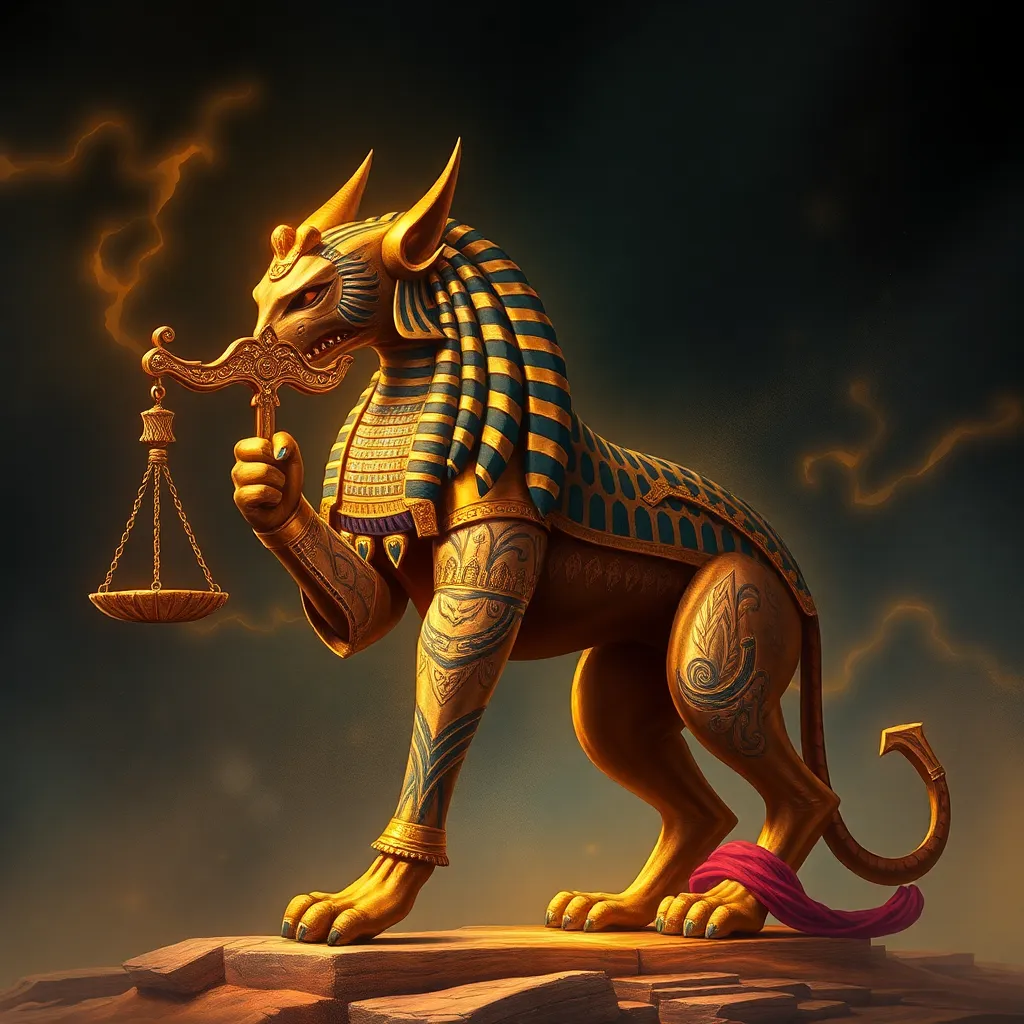Ammit: The Devourer and the Concept of Justice
I. Introduction
Ammit, often referred to as the “Devourer,” is a significant figure in ancient Egyptian mythology, symbolizing the complexities of justice and morality. As a creature of both fear and consequence, Ammit plays a pivotal role in the afterlife beliefs of the Egyptians, reflecting their values and societal norms.
Justice was a cornerstone of ancient Egyptian culture, deeply intertwined with their understanding of order, morality, and the afterlife. The concept of Ma’at, representing truth and justice, was central to the daily lives and spiritual beliefs of the Egyptian people. This article aims to explore the symbolism of Ammit and its relation to justice, providing insight into the ancient beliefs that continue to resonate today.
II. Understanding Ammit: The Devourer
Ammit is often depicted as a fearsome creature, part lion, hippopotamus, and crocodile—three of the most dangerous animals in ancient Egypt. This hybrid nature makes her an ominous figure, embodying the dangers that await those who fail to live a just life.
In the afterlife, Ammit plays a crucial role during the weighing of souls. She is present at the judgment of the deceased, where their hearts are weighed against the feather of Ma’at, the goddess of truth and justice. If a person’s heart is found to be heavier than the feather, indicating a life of wrongdoing, Ammit is there to devour the heart, condemning the individual to non-existence.
Ammit can be compared to other deities in Egyptian mythology, such as Anubis, the god of mummification and the afterlife, who guides souls to their judgment. While Anubis represents protection and guidance, Ammit embodies the consequences of one’s actions, serving as a stark reminder of the importance of living a virtuous life.
III. The Weighing of the Heart Ceremony
The weighing of the heart ceremony is an essential aspect of ancient Egyptian funerary practices, conducted by Osiris, the god of the afterlife. During this ceremony, the deceased’s heart is placed on one side of a balance scale, while the feather of Ma’at is placed on the other.
The significance of this ceremony lies in the symbolic representation of morality:
- The heart: Represents the individual’s deeds and intentions in life.
- The feather of Ma’at: Symbolizes truth, justice, and order.
Ammit’s role in this ceremony is critical; she awaits the outcome of the weighing. If the heart is lighter or equal to the feather, the deceased is deemed pure and allowed to enter the afterlife. However, if the heart is heavier, Ammit devours it, signifying the eternal loss of the soul.
IV. Symbolism of Ammit
Ammit’s symbolism extends beyond her terrifying appearance. She represents:
- Fear and consequence: Her presence instills a sense of dread regarding moral failure and the repercussions that follow.
- Guardian and devourer: Ammit serves a dual role, protecting the sanctity of the afterlife while also punishing those who have strayed from the path of righteousness.
- Psychological implications: The fear of Ammit reflects the deep-seated human concerns about morality, justice, and the consequences of one’s actions.
V. The Concept of Justice in Ancient Egypt
At the heart of ancient Egyptian belief systems is the concept of Ma’at, which embodies truth, justice, and cosmic order. Ma’at is not just a principle; it is a divine force that governs both the natural world and human behavior.
The societal importance of justice in ancient Egypt was paramount for maintaining harmony and balance. Without justice, chaos would ensue, disrupting both the earthly realm and the afterlife. Ammit embodies the consequences of injustice, serving as a reminder that one’s actions have lasting impacts.
VI. Ammit in Popular Culture
In modern media and literature, Ammit has made a notable impact as a character representing justice and morality. References to Ammit can be found in various forms of entertainment, including:
- Movies and television shows that explore Egyptian mythology.
- Video games that incorporate mythological themes.
- Literature that draws on ancient myths to discuss contemporary issues of justice.
The character of Ammit continues to resonate with audiences, reflecting contemporary interpretations of justice and morality. The resurgence of interest in Egyptian mythology speaks to the universal themes of right and wrong, accountability, and the consequences of one’s actions.
VII. Lessons from Ammit: Justice and Morality Today
Ammit’s story offers valuable lessons that remain relevant in modern society. The themes of justice, accountability, and moral integrity are crucial in addressing contemporary issues:
- Reflection on justice: Ammit’s tale encourages individuals to consider their actions and the impact on others.
- Ongoing struggle for justice: The fight for justice and equality continues to be a pressing issue worldwide.
- Cautionary symbol: Ammit serves as a reminder of the importance of ethical behavior and the potential consequences of wrongdoing.
VIII. Conclusion
In conclusion, Ammit holds a significant place in the narrative of justice within ancient Egyptian mythology. She represents the duality of fear and consequence, serving as a guardian of the afterlife while also embodying the dire repercussions of a life lived unjustly.
The enduring legacy of Ammit invites us to reflect on our own understanding of morality and justice. As we navigate our lives and societies, let us embrace the principles of justice that Ammit symbolizes, striving for accountability and ethical behavior in all our actions.




